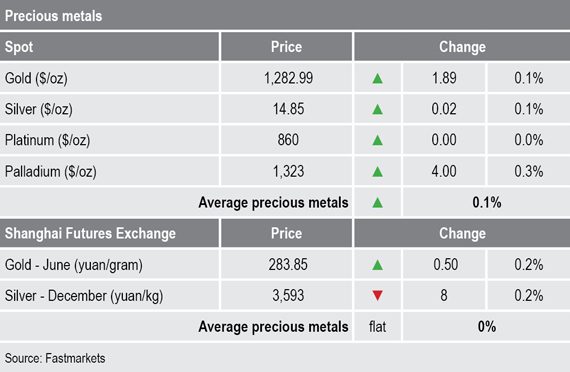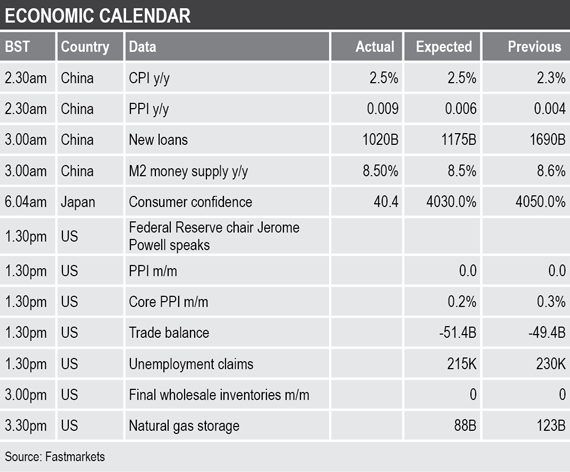- Asian equity markets are weaker
- The Japanese yen seems to be the haven asset of choice, while gold and US treasuries are little changed
- Base metals are soft, but price weakness seems cushioned for now
Base metals
Three-month base metals prices on the London Metal Exchange were weaker across the board, but only by an average of 0.3%. Nickel led on the downside with a 0.5% drop, while copper was little changed at $6,131 per tonne, compared with a close on Wednesday of $6,133 per tonne.
The overall trends on the price charts are pointing downward. This is more in line with the bigger economic picture that continues to face numerous headwinds from the US trade disputes with China and Europe, sanctions against Iran and Britain’s exit from the European Union.
In China, base metals prices on the Shanghai Futures Exchange were negative on Thursday, with the complex down by an average of 0.6% – led by a 1.4% drop in the June zinc contract. The June copper contract was off by 0.6% at 47,640 yuan ($7,027) per tonne, compared with Wednesday’s close of 47,910 yuan per tonne.
Spot copper prices in Changjiang were down by 0.8% at 47,460-47,560 yuan per tonne and the LME/Shanghai copper arbitrage ratio was recently at 7.76, compared with 7.72 at a similar time on Wednesday.
Precious metals
Spot precious metals prices were firmer on Thursday morning with the complex up by an average of 0.1% – the renewed stress in financial markets caused by the trade situation is prompting a risk-off climate with money coming out of equities, but the main recipient seems to be the yen, while gold and US treasuries are not up by that much. Gold was recently quoted at $1,282.99 per oz, compared with Wednesday’s close at $1.281.10 per oz.
On the SHFE, the June gold contract was up by 0.2% from Wednesday’s close, while the December silver contract was down by 0.2%.
Wider markets
In wider markets, the spot Brent crude oil price is weaker by 0.65% at $69.82 per barrel, compared with $70.28 per barrel at Wednesday’s close.
US treasuries yields were little changed at 2.4640%, compared with 2.4603% at a similar time on Wednesday. The yields on the US two-year and five-year treasuries remain inverted, they were recently quoted at 2.2854% and 2.2662% respectively.
The German 10-year bund yield has weakened further, it was recently quoted at -0.0500%, compared with -0.0378% at a similar time yesterday.
Asian equity markets were for the most part weaker: Nikkei (-0.93%), Hang Seng (-1.97%), CSI 300 (-1.53%) and the Kospi (-3.04%), while the ASX 200 bucked the trend with a 0.42% gain.
This follows a flat-to-stronger performance in western markets on Wednesday. In the United States, the Dow Jones Industrial Average closed up by 0.01% at 25,967.33, while in Europe the Euro Stoxx 50 was up by 0.47% at 3,417.26.
Currencies
The dollar index is consolidating, it was recently quoted at a slightly firmer 97.54, compared with 97.43 at a similar time on Wednesday.
The other major currencies are mixed, the yen is strengthening and was recently quoted at 109.84 compared with 110.05 at a similar time on Wednesday; the euro (1.1199) and sterling (1.3018) are consolidating, while the Australian dollar (0.6977) is weaker.
The yuan continues to weaken, it was recently quoted at 6.8014, compared with 6.7694, at a similar time on Wednesday and having traded either side of 6.7000 between February and April. The other emerging market currencies we follow are mixed, most are weaker showing a degree of stress, while the real and rand are firmer.
Key data
Thursday’s key economic data included the Chinese consumer and producer price indices (CPI & PPI) both of which came in higher than their previous readings, while Chinese new loans were weaker as was M2 money supply. Japanese consumer confidence at 40.4 was slightly down from the prior reading of 40.5. Data out later in the US includes PPI, the trade balance, initial jobless claims, wholesale inventories and natural gas storage. In addition, US Federal Reserve chair Jerome Powell is speaking.
Today’s key themes and views
The markets are rightly nervous – as seen by weaker equities in Asia this morning – but while the metals remain on a back footing, they are not losing too much ground. If the trade talks do crash and if tariffs are increased by the US and China then we would expect further price weakness. With the stakes high, an eleventh hour agreement, or at least an agreement to hold-off increasing tariffs, may well surface and that could then lead to a rebound. Overall we expect increased volatility in the days ahead.
Gold found some support on the increased market stress on Wednesday, but as expected the upside was limited and the ground gained in the rally was given back by the close. The overall trend remains to the downside, but given the trade tensions we would also expect volatility in gold to pick up.
This article was corrected on May 9 to reflect that Chinese vice premier Liu He is, in fact, attending trade talks in Washington, according to reports.



